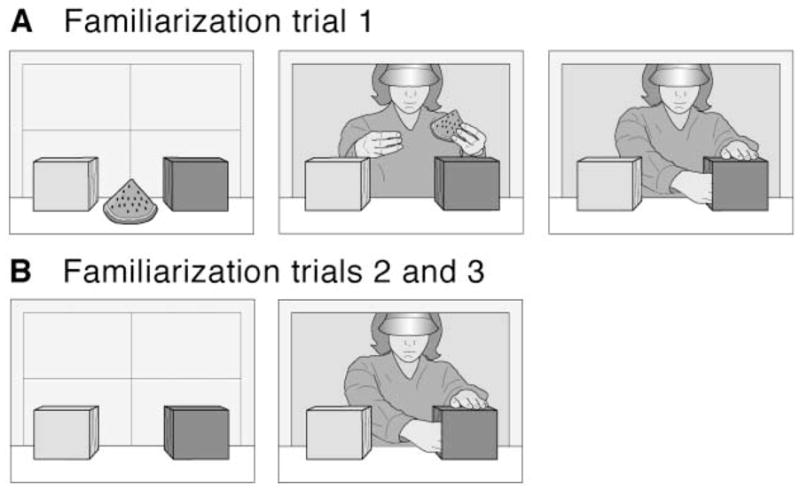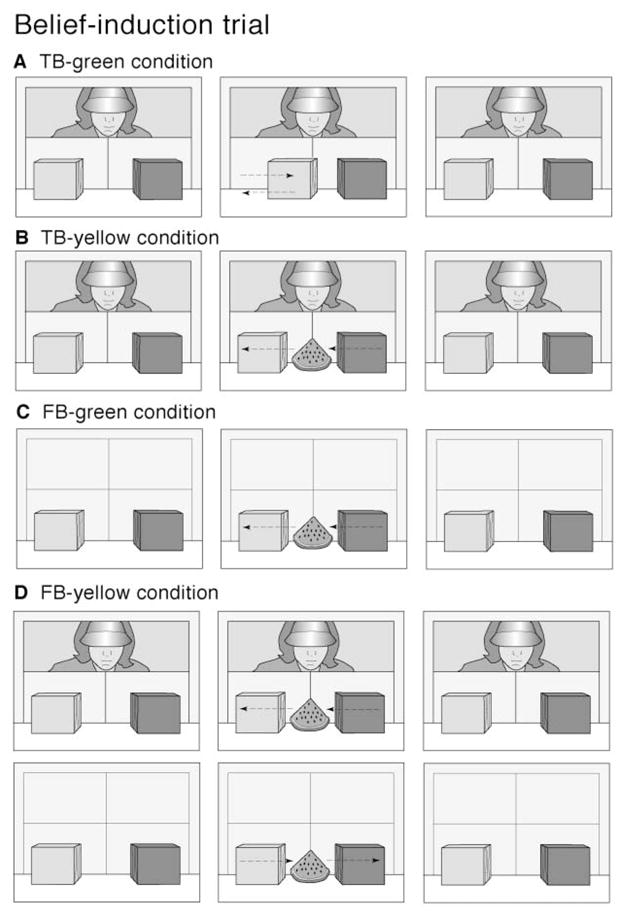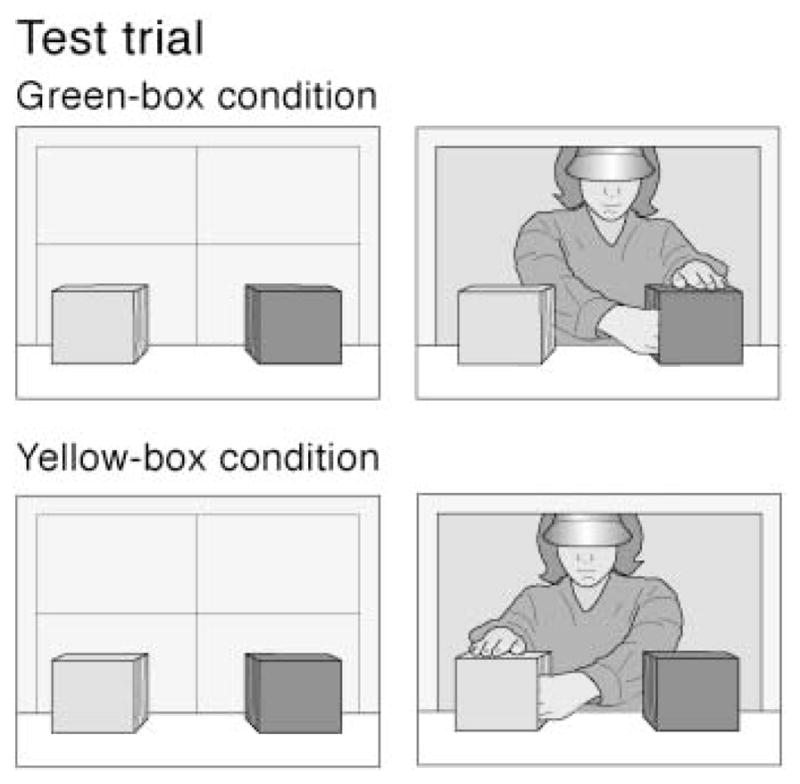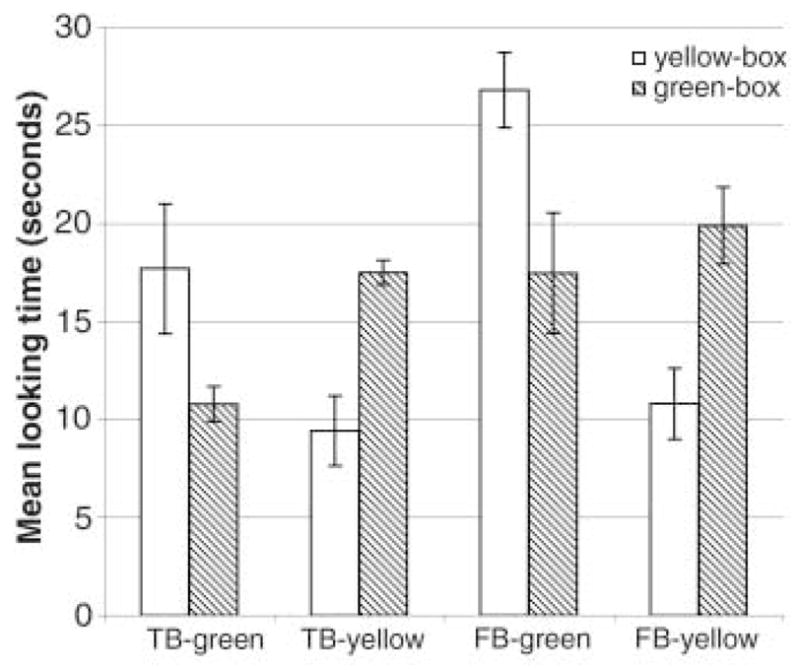Abstract
For more than two decades, researchers have argued that young children do not understand mental states such as beliefs. Part of the evidence for this claim comes from preschoolers’ failure at verbal tasks that require the understanding that others may hold false beliefs. Here, we used a novel nonverbal task to examine 15-month-old infants’ ability to predict an actor’s behavior on the basis of her true or false belief about a toy’s hiding place. Results were positive, supporting the view that, from a young age, children appeal to mental states—goals, perceptions, and beliefs—to explain the behavior of others.
Consider the following situation: A child who has surreptitiously eaten the last cookies in a box sees her brother reach into the box. To make sense of his behavior, she must understand that he falsely believes the box still contains cookies. As adults, we readily understand that others may hold and act on false beliefs; this ability is widely held to be a cornerstone of social competence, and its neuronal correlates have recently begun to be examined (1). What are the origins of this ability? Within the field of psychology, there has been a longstanding controversy regarding this issue (2–4).
Some researchers have suggested that at about 4 years of age a fundamental change occurs in children’s understanding of others’ behavior, or “theory of mind”: They begin to realize that mental states such as beliefs are not direct reflections of reality, which must always be accurate, but representations, which may or may not be accurate (5–8). Part of the evidence for this change from a nonrepresentational to a representational theory of mind has come from young children’s well-documented failure at false-belief tasks (i.e., tasks that require the understanding that others may hold and act on false beliefs) (9–13). In a standard task (10), children listen to a story as it is enacted with dolls and toys: The first character hides a toy in one location and leaves the room; while she is gone, a second character hides the toy in a different location. When asked where the first character will look for her toy, 4 year olds typically say she will look in the first location and provide appropriate justifications for their answers. In contrast, most 3 year olds say she will look in the second (actual) location, thus failing to demonstrate an understanding that the first character will hold a false belief about the toy’s location.
Other researchers have suggested that a representational theory of mind is present much earlier and that young children’s difficulties with the standard false-belief task stem primarily from excessive linguistic, computational, and other task demands (14–18). Support for these claims comes in part from evidence that 3 year olds and even some 2 year olds succeed at a modified false-belief task (19, 20). In this version of the task, after listening to the story and watching it enacted, children are simply probed by the experimenter to look where the first character will search for her toy upon her return (“I wonder where she will look”). Most children look to the correct location, suggesting that they possess some implicit understanding that others may hold and act on false beliefs. We examined whether 15-month-old infants tested with a simpler, entirely nonverbal task would also show some implicit understanding of false belief.
We used the violation-of-expectation method, which has been used extensively to investigate infants’ understanding of others’ goals (21–23). For example, in one experiment (22), infants were familiarized with an actor reaching for and grasping one of two toys (defined as the target toy). Next, the locations of the two toys were reversed, and the actor reached for the target or the nontarget toy. The infants looked reliably longer at nontarget reaches. This and control results suggested that the infants encoded the target toy as the actor’s goal object, expected her to reach for it in its new location, and responded with increased attention when she did not. Similar results were found when the target toy was hidden rather than visible and was retrieved by means-end action sequences rather than by a simple reach (23). Our research built on these results. In our experiment, 15-month-old infants first watched an actor hide a toy in one of two locations. Next, a change occurred that resulted in the actor holding either a true or a false belief about the toy’s location. The experiment asked whether the infants would expect the actor to search for her toy based on her belief about its location, whether that belief was true or false.
The infants first received three familiarization trials (Fig. 1). At the start of the first trial, a toy watermelon slice rested on the apparatus floor between two boxes, one yellow and one green; the boxes’ openings faced each other and were covered with fringe. An actor (wearing a beige visor and a denim shirt) opened doors in the back wall of the apparatus, grasped the toy, played with it for a few seconds, and then hid it inside the green box. After this pretrial, the actor paused, with her hand inside the box, until the trial ended (a curtain was lowered in front of the apparatus between trials). During the second and third familiarization trials, the actor opened the doors, reached inside the green box (as though to grasp the toy she had previously hidden there), and then paused until the trial ended. In all trials, looking times during the pretrial and paused portions of the trial were computed separately.
Fig. 1.

Events shown during (A) the first familiarization and (B) the second and third familiarization trials. The light gray box represents the yellow box; the dark gray box represents the green box.
Next, the infants received a single belief-induction trial (Fig. 2). During this trial, the infants witnessed a change that resulted in the actor holding a true or a false belief about the toy’s location. There were four versions of this trial, designed to yield two true-belief (TB) and two false-belief (FB) conditions: The actor could believe, truly or falsely, that the toy was hidden in the green or in the yellow box. In the TB-green condition, the actor was induced to have a true belief that the toy was in the green box. The upper halves of the doors in the back wall of the apparatus were open. The actor leaned into this opening and watched as the yellow box moved half the distance toward the green box and then returned to its original position; the infant and the actor thus observed no change in the toy’s location and could assume that it remained in the green box. In the TB-yellow condition, the actor watched through the opening in the back wall as the toy moved from the green into the yellow box; thus, both the infant and the actor saw the toy change location. The FB-green condition was identical to the TB-yellow condition except that the opening in the back wall remained shut throughout the trial; because only the infant saw the toy move into the yellow box, the actor should have a false belief about the toy’s location. The FB-yellow condition began as in the TB-yellow condition: The actor watched through the opening in the back wall as the toy moved from the green to the yellow box. Next, the actor shut the opening, and then the toy returned to the green box; thus, only the infant observed the toy’s second displacement, leaving the actor with a false belief that the toy was still in the yellow box. In each condition, following the pretrial, the infants watched the final paused scene until the trial ended. All but five infants (distributed among three conditions) looked continuously during the pre-trial, which lasted either 8 s (TB-green, TB-yellow, and FB-green) or 24 s (FB-yellow); the maximum time spent looking away for any individual was 0.6 s. The infants were thus very attentive throughout the pretrial.
Fig. 2.

Events shown during the belief-induction trial in the (A) TB-green condition, (B) TB-yellow condition, (C) FB-green condition, and (D) FB-yellow condition.
After the belief-induction trial, the infants received a single test trial (Fig. 3). For half of the infants in each belief condition, the actor opened the doors, reached into the green box, and paused until the trial ended (green-box condition); for the other infants, the event was the same except that the actor reached into the yellow box (yellow-box condition).
Fig. 3.

Events shown during the test trial.
Our predictions for the test trial were as follows: If the infants expected the actor to search for her toy on the basis of her belief about its location, rather than on the basis of (their knowledge of) its actual location, then they should look reliably longer when that expectation was violated. Thus, when the actor had a true belief that the toy was hidden in the green box, the infants should expect her to reach into that box and they should look reliably longer when she reached into the yellow box instead; conversely, when the actor had a true belief that the toy was hidden in the yellow box, the infants should look reliably longer when she searched the green as opposed to the yellow box. Exactly the same predictions held when the actor had a false belief about the toy’s location: The infants should look reliably longer at the yellow-box event when the actor falsely believed that the toy was hidden in the green box and at the green-box event when she falsely believed that the toy was hidden in the yellow box. Within both the true- and the false-belief conditions, an interaction was thus predicted between the actor’s belief about the toy’s location and her action in the test: In each case, the infants should look reliably longer when the location the actor searched was inconsistent with her belief about the toy’s location.
Participants were 56 healthy-term infants, 27 female and 29 male, with a mean age of 15 months, 7 days (range: 14 months, 27 days to 15 months, 18 days). Seven infants were randomly assigned to each of the eight groups formed by crossing the three experimental factors: the actor’s belief about the toy’s location (green or yellow box), the status of the actor’s belief (true or false), and the location the actor searched during test (green or yellow box). Another 14 infants were tested but eliminated due to inattentiveness (4), looking more than 3 SD beyond the condition mean (4), fussiness (2), parental interference (2), or observer error (2) (24).
The infants’ looking times during the test trial (Fig. 4) were compared by means of an analysis of variance with actor’s belief about the toy’s location (green or yellow box), belief status (true or false), and actor’s action (green or yellow box) as between-subject factors. The predicted interaction between actor’s belief and actor’s action was reliable [F(1, 48) = 31.24, P < 0.0001], indicating that the infants expected the actor to reach where she believed the toy to be and looked longer when she did not. This interaction was also reliable within the true-belief [F(1, 24) = 14.49, P < 0.0008] and the false-belief [F(1, 24) = 16.69, P < 0.0004] conditions. Finally, planned comparisons indicated that, in each of the four belief conditions, infants expected the actor to search for her toy where she believed it to be hidden and looked reliably longer when she did not (for all conditions, F > 5.34, P < 0.05) (see supporting online material text for analyses).
Fig. 4.

Mean (±SE) looking times during the test trial (after the actor reached into the green or yellow box) in the four belief conditions.
Whether the actor believed the toy to be hidden in the green or the yellow box and whether this belief was in fact true or false, the infants expected the actor to search on the basis of her belief about the toy’s location. These results suggest that 15-month-old infants already possess (at least in a rudimentary and implicit form) a representational theory of mind: They realize that others act on the basis of their beliefs and that these beliefs are representations that may or may not mirror reality.
Could our results be explained in terms of low-level strategies the infants might have used to predict the actor’s behavior? Together, the four conditions demonstrate that the infants did not simply expect the actor to search where the toy was actually hidden (FB-green and FB-yellow), where she had previously searched (TB-yellow and FB-yellow), or where she had last attended (TB-green). In addition, the results make clear that the infants did not simply become confused when the actor held a false belief and expect her to repeat whatever action she had last performed (FB-yellow).
Could the infants have used a more sophisticated strategy that still fell short of attributing to the actor a belief about the toy’s location? Perhaps the infants brought to the task a superficial expectation (acquired through repeated observations) that a person looking for an object will search for it where she last saw it disappear. This interpretation (which could also be offered for the modified false-belief task described earlier) assumes that the infants (i) distinguished between their own and the actor’s perceptions; (ii) kept track of what the actor did and did not see; and (iii) understood that the actor’s perceptions (rather than their own) should be used to predict her behavior. On this interpretation, our research would add to previous findings on the ability of young children to keep track of others’ perceptions. For example, 2.7 year olds kept track of whether their parent was present or absent when a toy was hidden in a room; if the parent was absent, children were more likely to point to the toy’s location when the parent returned (25). According to this alternative interpretation, our research would extend these results by showing that 15-month-old infants respond appropriately even when the actor is mistaken, as opposed to simply ignorant, about the toy’s location and even when this information must be used to predict the actor’s behavior rather than guide their own.
We prefer our interpretation to the alternative interpretation just discussed for two reasons. The first is theoretical. Similar to other researchers (14–18), we assume that children are born with an abstract computational system that guides their interpretation of others’ behavior. In this view, even young children appeal to others’ mental states—goals, perceptions, and beliefs—to make sense of their actions; development involves primarily learning which states underlie which actions and not coming to understand that such states exist at all. The second reason is empirical. Recent results of ours have indicated that infants can predict where an actor will search for a hidden toy even when she does not see it disappear but must infer its location based on various (useful or misleading) cues (26, 27). To explain these and the present results, it is more parsimonious to assume that infants attribute to others beliefs that can be shaped and updated by multiple sources of information than to assume that infants form an extensive series of superficial expectations linking different perceptions to different actions. In short, we propose that the present results suggest that 15-month-old infants expect an actor to search for a toy where she believes, rightly or wrongly, that it is hidden. Such an interpretation calls into question the notion that preschoolers undergo a fundamental change from a nonrepresentational to a representational theory of mind.
Beyond these immediate conclusions, the present findings have potential implications for two fields of research. The first is atypical development. Autistic children generally fail standard false-belief tasks and as a result are often described as possessing a deficient theory of mind (10, 28). If nonverbal false-belief tasks could be adapted for use with this population, it would open new avenues of research into the nature and early detection of autism. The second field of research is that of animal cognition. Since the pioneering work of Premack and Woodruff (29), the issue of whether animals possess a theory of mind has attracted much attention (30). The development of various nonverbal false-belief tasks may lead to new insights in the field of animal cognition (31).
Supplementary Material
Acknowledgments
We thank K. Chambers, G. DeJong, C. Fisher, and G. L. Murphy for comments and suggestions; H. Song and the staff of the Infant Cognition Laboratory at the University of Illinois for their help with the data collection and analyses; and the parents who kindly agreed to participate in the research. This work was supported by a predoctoral traineeship from the National Institute of Mental Health (1 T32MH19990) to K.O. and by a grant from the National Institute of Child Health and Human Development (HD-21104) to R.B.
Footnotes
www.sciencemag.org/cgi/content/full/308/5719/255/DC1
Materials and Methods
References and Notes
- 1.Saxe R, Kanwisher N. Neuroimage. 2003;19:1835. doi: 10.1016/s1053-8119(03)00230-1. [DOI] [PubMed] [Google Scholar]
- 2.Gopnik A. Behav Brain Sci. 1993;16:1. [Google Scholar]
- 3.Flavell JH. Annu Rev Psychol. 1999;50:21. doi: 10.1146/annurev.psych.50.1.21. [DOI] [PubMed] [Google Scholar]
- 4.Wellman HM, Cross D, Watson J. Child Dev. 2001;72:655. doi: 10.1111/1467-8624.00304. [DOI] [PubMed] [Google Scholar]
- 5.Flavell JH, Green FL, Flavell ER. Cogn Dev. 1990;5:1. [Google Scholar]
- 6.Astington JW, Gopnik A. Br J Dev Psychol. 1991;9:7. [Google Scholar]
- 7.Perner J. Understanding the Representational Mind. MIT Press; Cambridge, MA: 1991. [Google Scholar]
- 8.Gopnik A, Wellman HM. In: Domain Specificity in Cognition and Culture. Hirschfeld L, Gelman S, editors. Cambridge Univ. Press; New York: 1994. pp. 257–293. [Google Scholar]
- 9.Wimmer H, Perner J. Cognition. 1983;13:103. doi: 10.1016/0010-0277(83)90004-5. [DOI] [PubMed] [Google Scholar]
- 10.Baron-Cohen S, Leslie AM, Frith U. Cognition. 1985;21:37. doi: 10.1016/0010-0277(85)90022-8. [DOI] [PubMed] [Google Scholar]
- 11.Wellman HM, Bartsch K. Cognition. 1988;30:239. doi: 10.1016/0010-0277(88)90021-2. [DOI] [PubMed] [Google Scholar]
- 12.Moses LJ, Flavell JH. Child Dev. 1990;61:929. [PubMed] [Google Scholar]
- 13.Zaitchik D. Cognition. 1990;35:41. doi: 10.1016/0010-0277(90)90036-j. [DOI] [PubMed] [Google Scholar]
- 14.Leslie AM. Psychol Rev. 1987;94:412. [Google Scholar]
- 15.Chandler M, Fritz AS, Hala S. Child Dev. 1989;60:1263. [PubMed] [Google Scholar]
- 16.Fodor JA. Cognition. 1992;44:283. doi: 10.1016/0010-0277(92)90004-2. [DOI] [PubMed] [Google Scholar]
- 17.Premack D, Premack AJ. In: The Cognitive Neurosciences. Gazzaniga MS, editor. MIT Press; Cambridge, MA: 1995. pp. 205–218. [Google Scholar]
- 18.Bloom P, German TP. Cognition. 2000;77:B25. doi: 10.1016/s0010-0277(00)00096-2. [DOI] [PubMed] [Google Scholar]
- 19.Clements WA, Perner J. Cogn Dev. 1994;9:377. [Google Scholar]
- 20.Garnham WA, Ruffman T. Dev Sci. 2001;4:94. [Google Scholar]
- 21.Gergely G, Nádasdy Z, Csibra G, Biró S. Cognition. 1995;56:165. doi: 10.1016/0010-0277(95)00661-h. [DOI] [PubMed] [Google Scholar]
- 22.Woodward AL. Cognition. 1998;69:1. doi: 10.1016/s0010-0277(98)00058-4. [DOI] [PubMed] [Google Scholar]
- 23.Onishi KH, Baillargeon R, Woodward AL. in preparation. [Google Scholar]
- 24.Materials and methods are available as supporting material on Science Online.
- 25.O’Neill DK. Child Dev. 1996;67:659. [Google Scholar]
- 26.Onishi KH, Baillargeon R. paper presented at the International Conference on Infant Studies; Chicago, IL. 6 to 10 May 2004. [Google Scholar]
- 27.Baillargeon R. paper presented at Munich Encounters in Cognition and Action, Max Planck Institute for Human Cognitive and Brain Sciences; Munich, Germany. 5 November 2004. [Google Scholar]
- 28.Baron-Cohen S. Mindblindness: An Essay on Autism and Theory of Mind. MIT Press; Cambridge, MA: 1997. [Google Scholar]
- 29.Premack D, Woodruff G. Behav Brain Sci. 1978;1:515. [Google Scholar]
- 30.Heyes CM. Behav Brain Sci. 1998;21:101. doi: 10.1017/s0140525x98000703. [DOI] [PubMed] [Google Scholar]
- 31.Hare B, Call J, Tomasello M. Anim Behav. 2001;61:139. doi: 10.1006/anbe.2000.1518. [DOI] [PubMed] [Google Scholar]
Associated Data
This section collects any data citations, data availability statements, or supplementary materials included in this article.


